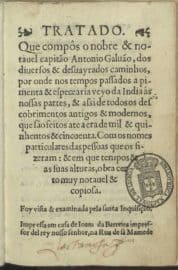
There is a surprising ancient history of the world which opens with the narrative of the ancient world being colonized by China.
It was first published in Lisbon in 1563 and the author is António Galvão (1490-1557) known as Antonio Galvano outside his country, a former governor of the Maluku Islands.
Tratado que compôs o nobre & notauel capitão Antonio Galuão, dos diuersos & desuayrados caminhos, por onde nos tempos passados a pimenta & especearia veyo da India ás nossas partes, & assi de todos os descobrimentos antigos & modernos, que são feitos até a era de mil & quinhentos & cincoenta…. – [Lisboa] : impressa em casa de Ioam da Barreira, impressor del rey nosso senhor, na Rua de sã Mamede, 15 Dezembro 1563.
He was the son of Duarte Galvão, an ambassador for the King of Portugal Afonso V, who lost his life and freedom going to Ethiopia in 1515 with a letter for the Prester John. Duarte was welcomed there by the natives but then they forbid departing. A fate similar to that of Andrea Corsali, a Tuscan explorer and friend of Leonardo da Vinci.

Galvão calls the Chinese Taibechs (Tai-bin, that is the Great Ming in Xiamen’s dialect) and he added that his ‘Indian’ informers told him that in the past they had ruled over all of the East, including Japan and not only that, they even extended their rule over the Easter costs of Africa, then to Brazil and Peru. He then interprets a passage from the Roman historian Cornelius Nepos, who said that some Indians (the generic name for Asians) had landed on the coast of Germany to trade products from their country. This, according to Galvão, should be seen as a proof that they were in fact from China. The recent find of skeletons of Chinese in a late Roman cemetery in London add new fuel to this hypothesis.
Antonio departed to the East in 1520 – perhaps looking for his father – as a simple foot soldier, then again in 1524 having gained the rank of captain of a ship. He was back in Lisbon in 1527 with the bones of his father, recovered by the missionary Francisco Alvares.
In 1532 he sailed again and in 1536 took charge as governor of the ‘spice islands’. In 1540 he was recalled and he handed the government of the fortress to D. Jorge de Castro and returned to Portugal, with great hopes.
Heavily in debt he expected a sign of favor from his King, in the form of a pension. But his hopes were dashed and died destitute in 1557, after spending the last years of his life on charity as a homeless sleeping inside a wing of the Hospital of Todos-os-Santos.
A proof of his open-mindedness, sincerity and global view of world’s history could be seen also by his mentioning the arrival of native Americans on a canoe in Lubeck, Northern Germany, at the time of Emperor Barbarossa. A fact also mentioned by López de Gómara in his 1550’s book on the Spanish conquest of the New World.
António Galvão left two unpublished manuscripts. One was the treaty of the discoveries printed after his death, in 1563, in Lisbon by his friend Francisco de Sousa Tavares. The second was the Historia das Molucas, da natureza, e descubrimento daquellas terras divida em 10 livros, which was given by Francisco de Sousa Tavares to the crown and a good part was later used by Damião de Góis for his Chronica (1566-67).

